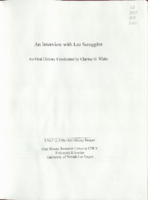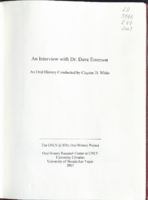Search the Special Collections and Archives Portal
Search Results

Transcript of interview with Dr. Lonnie D. Spight by Dr. David Emerson, May 8, 2007
Date
2007-05-08
Archival Collection
Description
Dr. Lonnie D. Spight grew up in northern Colorado, earned his bachelor's degree at Colorado State University, and his PhD at University of Nevada Reno. His interest in astronomy dates from his early years on the farm in Colorado, star-gazing in the fields at night. Before coming to UNLV, Lonnie worked for the Department of Defense on scattering cross sections and explosions. Working between Los Alamos and the Test Site, he was often in Las Vegas and had met most of the physicists at the university. He was invited midterm to take over a physics class for a faculty member who had fallen ill, and was offered a job the following fall of 1970. In the seventies when Dr. Spight arrived, the physics department was located in trailers, and the university campus was mostly desert. Lonnie served as chair of the department on several occasions, and was responsible for insisting that faculty members get involved in research, no matter how tight the budget. He worked on solar energy and far-field microwave analysis, and helped set up safety standards for the new laser technology. One of Dr. Spight's interests outside of physics is a love for classical music. He was a volunteer "Deejay" for 12 years with KNPR once it got started in 1980. Meanwhile, after 37 years with UNLV Lonnie retains his enthusiasm and love for teaching. Today he teaches quantum mechanics and hopes that one day he will be able to teach a particle physics course which ties together cosmology, the beginning of the universe, fundamental cutting edge physics, quarks, gluon plasmas, and more. He has the course materials ready to go and is looking forward to many more years at UNLV.
Text

Transcript of interview with Harvey Allen by Claytee D. White, December 5, 2006
Date
2006-12-05
Archival Collection
Description
Harvey Allen grew up poor in Philadelphia. After taking singing lessons at the Artie Singer Vocal School, he got jobs singing in night clubs up and down the east coast. He also took acting classes in New York and performed at the Copa Club. In the 1950s, he moved to Las Vegas and auditioned for Jack Entratter at the Sands Hotel and Casino where he performed with numerous entertainers including Lena Horne, Louis Armstrong, Tallulah Bankhead and Robert Merrill. Allen's accomplishments include attending and obtaining a degree in telecommunications and film from San Diego State and a Master's degree from UNLV. He worked for the American Society of Composer, Authors and Publishers. Harvey recalls working on a segregated strip and the opening of the first integrated casino in Las Vegas, The Moulin Rouge. Twice he moved from Las Vegas but always returned. He implemented National Reading Week for the State Department of Education and was the emcee for Sunrise Hospital Cancer Survivors Week. In addition to hosting a popular talk show on KDON radio, he hosted the "All-Nighters Club Convention", taught classes at UNLV tor 31 years and wrote a column in Maturity Today. Now Harvey is at a different stage of his life. He and his wife are active in running their public relations agency, enjoying their garden, taking great photographs and spending time together in their fabulous home in Anthem.
Text

Transcript of interview with Lee Scroggins by Claytee D. White, February 27, 2009
Date
2009-02-27
Archival Collection
Description
From a Montana childhood filled with memories of sub-zero winters to a whirlwind courtship and wedding to her husband of over three decades, Lee Scroggins brought an energy to all her administrative positions at UNLV. Lee and her family moved to Las Vegas in March 1980. Within a couple of months she was working at UNLV and except for a brief hiatus in the late 1980s she remained at the university until her retirement in 2009. She gives an account of her journey through the office staff levels she held. It began with a brief stint in the Education department (you couldn't rise a level until you had six months in one position); took her to the Business and Economics departments; the 1980s. After her hiatus from 1985 to 1988, she returned to UNLV to work in the Psychology department and eventually to the library. Her interview traverses the evolution of the administrative worker from a time without technologies that became the common tools. It was an era without many copy machines, no Xerox, or computers. In addition, Lee touches upon procedural changes that were inevitable as the university grew In retirement, Lee plans to "call her own shots" and enjoy life.
Text
California Council on Problem Gambling, "When the Stakes Are Too High: Understanding Problem Gambling" informational packet including fliers, video recording, projection slides, and informational materials, 2003
Level of Description
File
Archival Collection
Katherine A. Spilde Papers on Native American Gaming
To request this item in person:
Collection Number: MS-00092
Collection Name: Katherine A. Spilde Papers on Native American Gaming
Box/Folder: Box 73
Collection Name: Katherine A. Spilde Papers on Native American Gaming
Box/Folder: Box 73
Archival Component
PIC (Planning Information Corporation) 1998. Baseline Economic/Demographic Projections for 1999-2008: Nye County and Nye County Communities. Denver, Colorado: Planning Information Corporation, 1998
Level of Description
File
Archival Collection
Environmental Radiation Protection Standards for Yucca Mountain, Nevada
To request this item in person:
Collection Number: MS-00603
Collection Name: Environmental Radiation Protection Standards for Yucca Mountain, Nevada
Box/Folder: Box 43
Collection Name: Environmental Radiation Protection Standards for Yucca Mountain, Nevada
Box/Folder: Box 43
Archival Component
Bradshaw, L. W ., 1995, letter to Dr. D. Dreyfus (Office of Civilian and Radioactive Waste Management, U.S. Department of Energy). October 4, Nuclear Waste Repository Project Office, Tonopah. Nevada, 1995
Level of Description
File
Archival Collection
Environmental Radiation Protection Standards for Yucca Mountain, Nevada
To request this item in person:
Collection Number: MS-00603
Collection Name: Environmental Radiation Protection Standards for Yucca Mountain, Nevada
Box/Folder: Box 21
Collection Name: Environmental Radiation Protection Standards for Yucca Mountain, Nevada
Box/Folder: Box 21
Archival Component
DOE (U.S. Department of Energy), 1995, YMP Erionite Control Protocol, Office of Civilian Radioactive Waste Management, Yucca Mountain Project Office, Las Vegas, Nevada, 1995
Level of Description
File
Archival Collection
Environmental Radiation Protection Standards for Yucca Mountain, Nevada
To request this item in person:
Collection Number: MS-00603
Collection Name: Environmental Radiation Protection Standards for Yucca Mountain, Nevada
Box/Folder: Box 21
Collection Name: Environmental Radiation Protection Standards for Yucca Mountain, Nevada
Box/Folder: Box 21
Archival Component
Aerial view, northwest, of entire project: reservoir (lower left), demountable house site (center right), plant site (upper right): photographic print, 1942 March 31
Level of Description
Item
Archival Collection
Basic Magnesium, Inc. (BMI) Records and Photographs
To request this item in person:
Collection Number: MS-00126
Collection Name: Basic Magnesium, Inc. (BMI) Records and Photographs
Box/Folder: Box 05
Collection Name: Basic Magnesium, Inc. (BMI) Records and Photographs
Box/Folder: Box 05
Archival Component
Regional Transportation Plan Update; 1993 Revised Road and Street Project List and Aird Quality Conformity Determinatino by Regional Transportation Commission of Clark County, Nevada, 1993 April
Level of Description
File
Archival Collection
Clark County Planning Commission Research Library Collection
To request this item in person:
Collection Number: MS-01027
Collection Name: Clark County Planning Commission Research Library Collection
Box/Folder: Box 53
Collection Name: Clark County Planning Commission Research Library Collection
Box/Folder: Box 53
Archival Component

Transcript of interview with Dr. David Emerson by Claytee D. White, December 21, 2005
Date
2005-12-21
Archival Collection
Description
Dr. Dave Emerson was born in Littleton, Massachusetts. His father, a mining engineer, moved the family to Mexico twice, once when Dave was one year old and again when he was seven. In 1938, his father retired to work on his apple orchard in Littleton. Dave helped with pruning, spraying and dusting for insects, and hauling apples to the cider mill. Dr. Emerson graduated from high school in Littleton in 1945 and joined the army. Because he was only 17, the army sent him to Norwich University in Vermont until he turned 18. He then went on active duty until December, 1947. After he mustered out, Dartmouth College accepted his credits and he completed courses through his junior year. He was then called back to active duty in the Korean conflict, and was assigned to the Army Chemical Center in Maryland. After his army stint, Dr. Emerson worked a summer for Dow Chemical as a research engineer, and then returned to Michigan to pursue a Master's degree. He met and married his wife during this time. After completing his doctorate, Dave went to work for Shell Oil Company. Dave spent six years with Shell and decided to turn to teaching. He took a job at a branch of the University of Michigan. He worked there 17 years, doing research, teaching, and even spending a little time as chairman of the Division of Art, Sciences, and Letters. He was then notified of an opening at UNLV for dean of the College of Science, Math, and Engineering. In 1981, Dr. Emerson and his wife moved to Las Vegas, and he began teaching chemistry classes. He was instrumental in building up the engineering department through distance education for students who needed credits in math, computer skills, or electrical engineering. He also helped put together and sell the idea of a strong engineering school at UNLV, and then worked to gain accreditation for civil, mechanical, electrical and other areas of engineering. After retiring in 1998, Dr. Emerson worked on the self-study for the year 2000 accreditation. He still does research at UNLV on a volunteer basis. He and his wife continue to enjoy their home here in Vegas as well as their travels around the country.
Text
Pagination
Refine my results
Content Type
Creator or Contributor
Subject
Archival Collection
Digital Project
Resource Type
Year
Material Type
Place
Language
Records Classification
